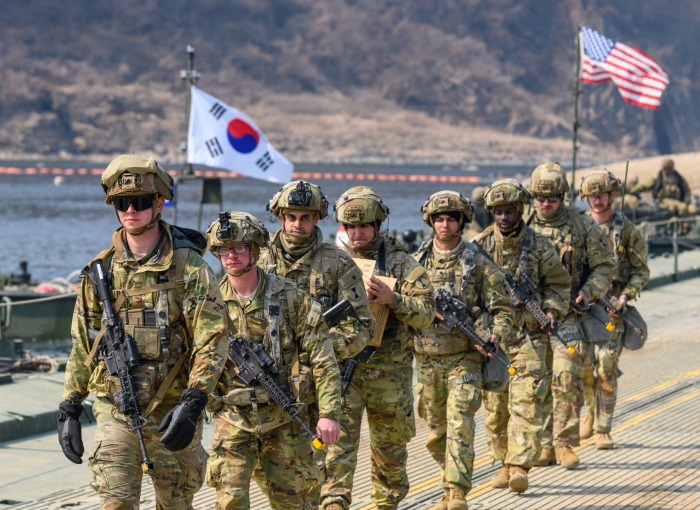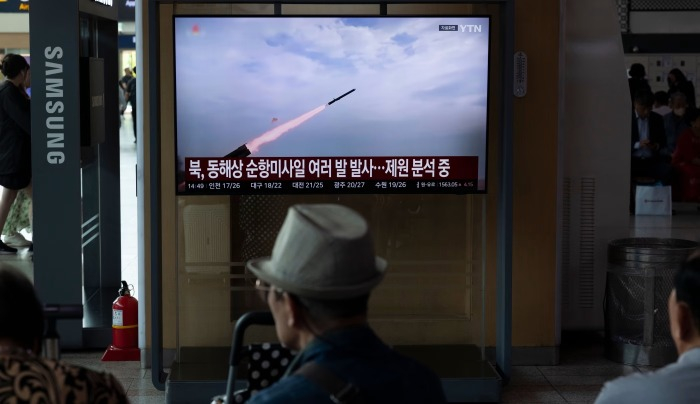US considers withdrawing thousands of troops from South Korea
The Trump administration contemplates moving roughly 4,500 US forces to Guam or other locations in the region
By The Wall Street Journal 8 HOURS AGO
South Korea’s Rznomics inks $1.3 bn out-licensing deal with Eli Lilly


Korea’s aesthetic medicine enjoys golden era with surge in foreign spending


In China’s waterway city Hangzhou, K-beauty redefines ‘shuiguang'


When in S. Korea, it’s a ritual: Foreigners make stops at CU, GS25, 7-Eleven


Kumho Tire shuts Gwangju plant after fire, derailing record sales run



WASHINGTON—The Trump administration is weighing a withdrawal of thousands of American troops from South Korea, according to defense officials familiar with the discussions, a move that could stir new anxiety among allies worried about the White House's commitment to Asia.
An option being developed by the Pentagon is to pull out roughly 4,500 troops and move them to other locations in the Indo-Pacific region, including to Guam, the officials and a person familiar with the matter said. The idea is being prepared for consideration by President Trump as part of an informal policy review on dealing with North Korea, two of the officials said.
The proposal has yet to reach Trump’s desk and is one of several ideas under discussion by senior officials conducting the review, the two officials said.
Asked about the discussion of a troop drawdown, a Pentagon spokesman said there were no policy announcements to make. National Security Council spokesman Pete Nguyen didn’t address the troop-withdrawal issue but said Trump was committed to the “complete denuclearization” of North Korea. South Korea’s defense ministry declined to comment.
Since his first term, Trump has considered changing the U.S. footprint in South Korea, where there are about 28,500 troops.
Last month, top commanders overseeing U.S. forces in Asia warned against reducing their numbers, saying a drawdown would jeopardize their ability to prevail against North Korea, and in other possible conflicts against China and Russia that could arise in Northeast Asia.
Army Gen. Xavier Brunson, the commander for U.S. forces in Korea, advised against a drawdown in congressional testimony, saying “to reduce the force becomes problematic.”
That assessment was echoed at the same April 10 Senate Armed Services Committee hearing by Adm. Samuel Paparo, the top commander in the region, who said of taking forces from South Korea: “Inherently, it would reduce our ability to prevail in conflict.”
U.S. officials say a decision on troop levels won’t come until there is more clarity about the direction of the war in Ukraine and whether the administration will keep supporting Kyiv militarily.
Serious consideration to a South Korea troop withdrawal would likely cause alarm across the Indo-Pacific. South Korea, along with Japan and the Philippines, rely on close coordination with American armed forces to defend themselves and project power in an increasingly contentious region.
The U.S. military presence there has long been seen as a deterrent against a renewed war on the Korean Peninsula, as well as against an aggressive China, which asserts claims over a swath of the South China Sea and has threatened to take control of Taiwan.
Removing forces from the Korean Peninsula but keeping them in the region might lessen Pentagon concerns about a drawdown. Guam is emerging as a crucial Pentagon hub for forces because it is close enough to potential hot spots but harder for Chinese forces to reach.
On his first official trip to Asia earlier this year, Defense Secretary Pete Hegseth said he wants the U.S. and allies to re-establish deterrence and promised an “unprecedented” shift to the region.
Yet maintaining a large-enough U.S. force posture in South Korea remains a central concern for the Pentagon and for Seoul.

Elbridge Colby, the undersecretary of defense for policy, has long advocated pushing South Korea to assume more of the burden of defending itself with conventional forces to enable the U.S. to better confront China, even as the U.S. maintains its commitment to defend Seoul from Pyongyang, if necessary with nuclear weapons.
“I’m not in favor of withdrawing forces from South Korea, as I have repeatedly laid out,” Colby said in a post on X last year before he was nominated for his Pentagon post. “I’m in favor of reshaping U.S. forces in the ROK to focus on China while the ROK takes the great burden of conventional defense against the DPRK.”
ROK refers to the Republic of Korea, the formal name for South Korea, while DPRK stands for the Democratic People’s Republic of Korea, as North Korea is called.
In response to a military buildup by China, the Pentagon has moved more military equipment to the region in recent years, increased multilateral exercises with allies and deployed new mobile units designed to jump from island to island.
Pyongyang last year abandoned its decades-long policy of peaceful reunification, declaring Seoul its primary enemy. North Korea regularly conducts weapons launches. On Thursday, it fired cruise missiles.
Write to Timothy W. Martin at Timothy.Martin@wsj.com
Write to Nancy A. Youssef at nancy.youssef@wsj.com
Write to Alexander Ward at alex.ward@wsj.com
-
 EconomyTrump’s tariffs are hitting exports, early Korean data show
EconomyTrump’s tariffs are hitting exports, early Korean data showApr 23, 2025 (Gmt+09:00)
1 Min read -
 Aerospace & DefenseSouth Korean defense industry thriving on strong overseas demand
Aerospace & DefenseSouth Korean defense industry thriving on strong overseas demandApr 15, 2025 (Gmt+09:00)
3 Min read -
 Business & PoliticsS.Korea's Han, Trump discuss transactional diplomacy in 1st direct talks
Business & PoliticsS.Korea's Han, Trump discuss transactional diplomacy in 1st direct talksApr 09, 2025 (Gmt+09:00)
3 Min read -
 Business & PoliticsAsia’s defense stocks climb on hopes of more European arms spending
Business & PoliticsAsia’s defense stocks climb on hopes of more European arms spendingMar 05, 2025 (Gmt+09:00)
2 Min read -
 Aerospace & DefenseS.Korea’s defense order backlog reaches record $73.1 billion at end-2024
Aerospace & DefenseS.Korea’s defense order backlog reaches record $73.1 billion at end-2024Feb 17, 2025 (Gmt+09:00)
3 Min read


